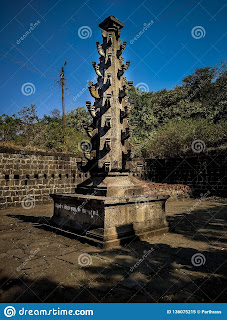 |
| stone monument of Deepa Stambha, dreamstime.com |
A pillar or column often referred to as a stambha (tower) may be of few types and here we're concerned about the Deepa Stambha of the Hindu temples. The mythological and religious connotation is the Deepa stambha not only refers to a link between the sky (heaven) and earth but also God Shiva who -represents one of the Pancha Boothas- Agni, the other being water, earth sky and air. A reference is made in the Atharva Veda, ''a celestial stambha as being an infinite scaffold, which supports the cosmos and material creation''.
As the name implies Deep Jyoti Stambh (Deep meaning deepam or light, Jyoti meaning “light,” and Stambha implies “a column”) or Deepa Stambha is a tall column of pillar or post for diya - oil lamp. It comes in different shapes and sizes and of different heights. Most commonly placed at the entrance of the Hindu temple inside the compound wall, the Deepa Stambha with many small receptacles for oil and wick from top to bottom will be illuminated on festive days or on important occasions. Across India one can see such Deepa stambha. mention may be made of Maharashtra, Goa and Kerala states.
Though the use of oil lamps has been around in Hinduism for centuries, many of us are not aware why oil lamps are being used in Hindu temples and homes. Oil lamp has been part of traditional Hindu worship across India. Apart from providing an ambience of energy and positivity, it is symbolic of knowledge and removal of ignorance and negativity in the environment. Knowledge removes ignorance, so does light that removes darkness. Light is also a symbol of plenty and prosperity where there is no room for negativity.
The light is more a symbol of divinity than other aspects, hence oil lamps are kept in sanctified places like temples, particularly in the sanctum - garbagriha or puja rooms in homes to keep the ambiance in energetic and positive mode. The Hindu festivals of Deepavali and Thiru Karthikai Deepam are linked to fire (Agni). At one of the Pancha Boothasthalas in Tamil Nadu at Thiruvannamalai God Shiva (Arunachaleswarar) symbolizes a ''huge column of Agni touching heaven and earth.'' He is alsoman embodiment of “Knowledge and Wisdom” (chaitanya). This is the reason why we keep oil lamps lit during all important and auspicious occasions like Wedding, Grihapravesam, Seemandham (Valaikappu), temple rituals, puja, etc.
The following are temples where one can see Deepa stambha or Vilakku Stand:
.jpg) |
| Stone lamp stand (Kal Vilakku). Kerala alamy.com |
 |
| Guruvayoor temple Vilakku stand. aanmeegam.in |
 |
Deepa stamha or Vilakku Stand, Guruvayoor temple, Kerala templedairy.in
|
 |
| Vaikom Mahadeva temple, Kerala. Deepa stands. blessingsonthenet.com |
 |
| Khandoba temple, Jejuri, Pune Dist. dreamstime.com |
 |
| Khandoba, Jejurt, MH. .tripadvisor.com |
Above images: Commonly called Khandoba, Martanda Bhairava, or Malhar Temple, Jejuri, MH, it is about 39 km from Pune city. The worship of Martanda Bhairava, a Hindu deity common in the states of Maharashtra and North Karnataka. A form of God Shiva for countless families in the Deccan region, he is the family deity - most popular Kuladevataparticularly for select warrior farming castes, Here the illumination Deepa Stampha is a common feature on festive days. ooo
 |
| Kolhapur Mahalaxmi temple with Deepa Stambhas, MH.picxy.com |
 |
| Deepa stambha of Ancient Mahalaxmi Temple , Kolhapur twitter.com |
 |
| Deepastambha of Ancient Mahalaxmi Temple , Kolhapurt.alamy.com |
Above image: Mahalakshmi Temple (also known as Ambabai Mandir) of Kolhapur, MH dedicated to Goddess Lakshmi, consort of God Vishnu is a popular Hindu temple in this part. It has been a custom for many devotees to visit Tirumala Venkateswara Temple, Kolhapur Mahalakshmi Temple and Padmavathi Temple,near Thirupati as a yatra (pilgrimage) to get salvation - Moksha. Though its origin may go back to 634 CE Karnadeva in 634 CE, the architecture of this temple is that of the Chalukya empire who had built it in the 7th century.
oo
.jpg) |
Mahalsa Narayani temple, Goa.dreamstime.com
|
Above image: Goddess Mahalsa Narayani is believed to be the female avatar of Lord Vishnu. Goddess Mahalsa. Often simply referred to as Narayani, she is a slayer of demon Rahu. In this fierce avatar, she is referred to as Rahu-matthani or Rahu's slayer.
The temple is marked by a 40 feet high Samai, an ornamental lamp pole that has 21 rings hosting 150 wicks each, tapering in shape up to its height. A Dyandeepa or a lamp of wisdom and one of the tallest deepa stambha or lamp tower are installed next to it. The lamp artefacts require an industrial grade sliding ladder mounted on a stand with wheels to light up. This deepa stambha is illuminated on festive or special days.
ooo
 |
| Harsidhhi Temple, Ujjain ujjaindarshan.com |
Above image; Deepa stambha at Harsiddhi Temple, Ujjain: Harsiddhi is an aspect of Hindu goddess Durga widely worshipped in states like Gujarat, Madhya Pradesh, adjoining Maharashtra
ooo
 |
| Shantadurga temple of north Goa |
astrolika.com |

.jpg)







.jpg)

%20(2).jpg)











